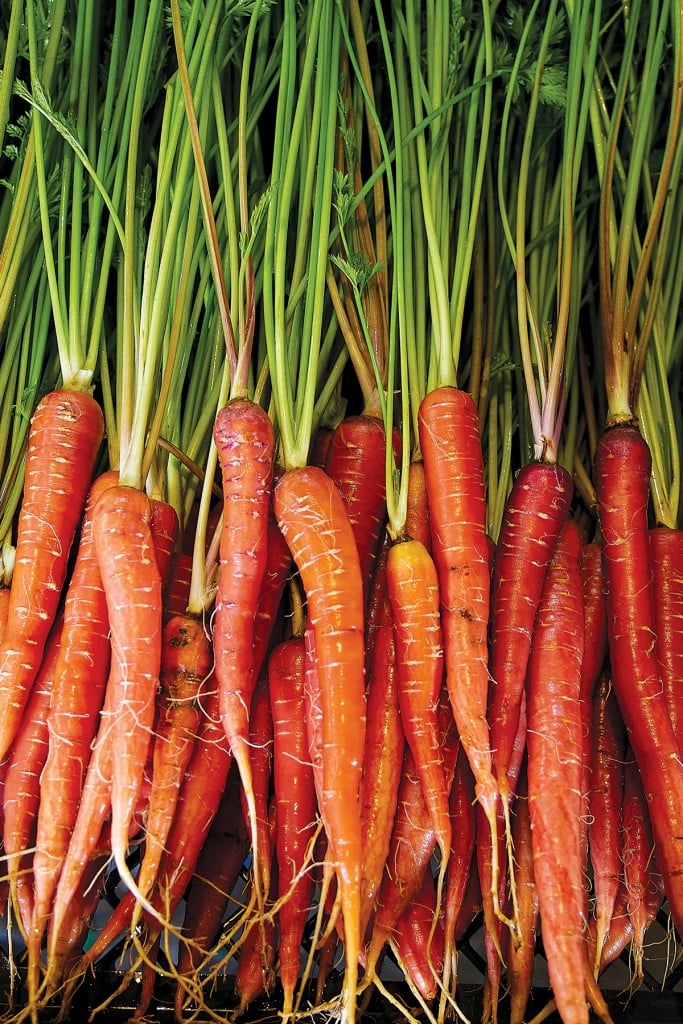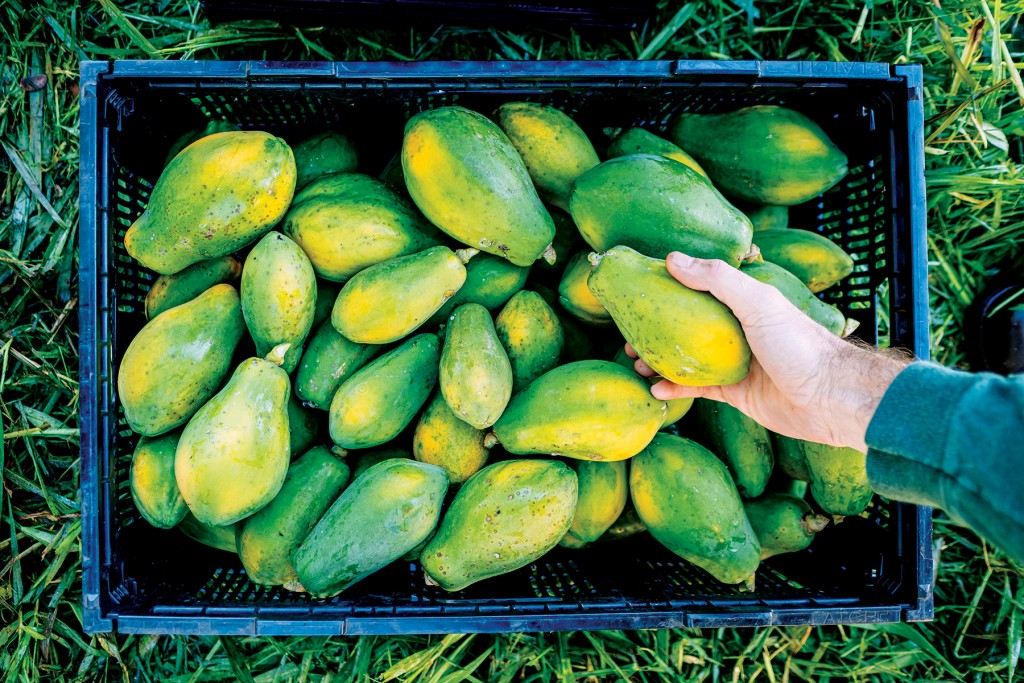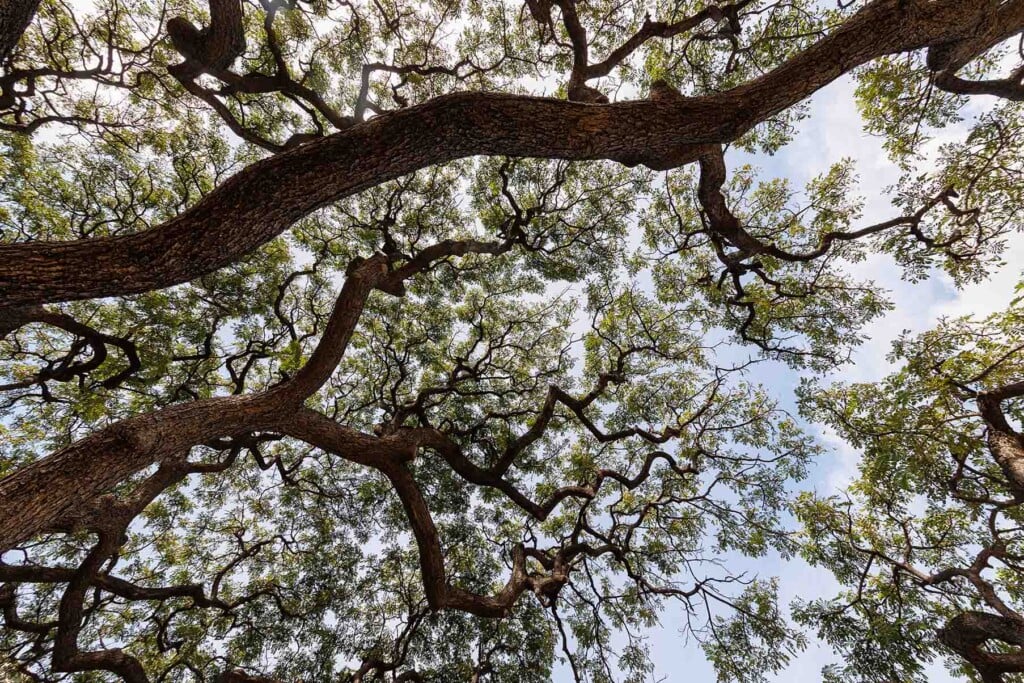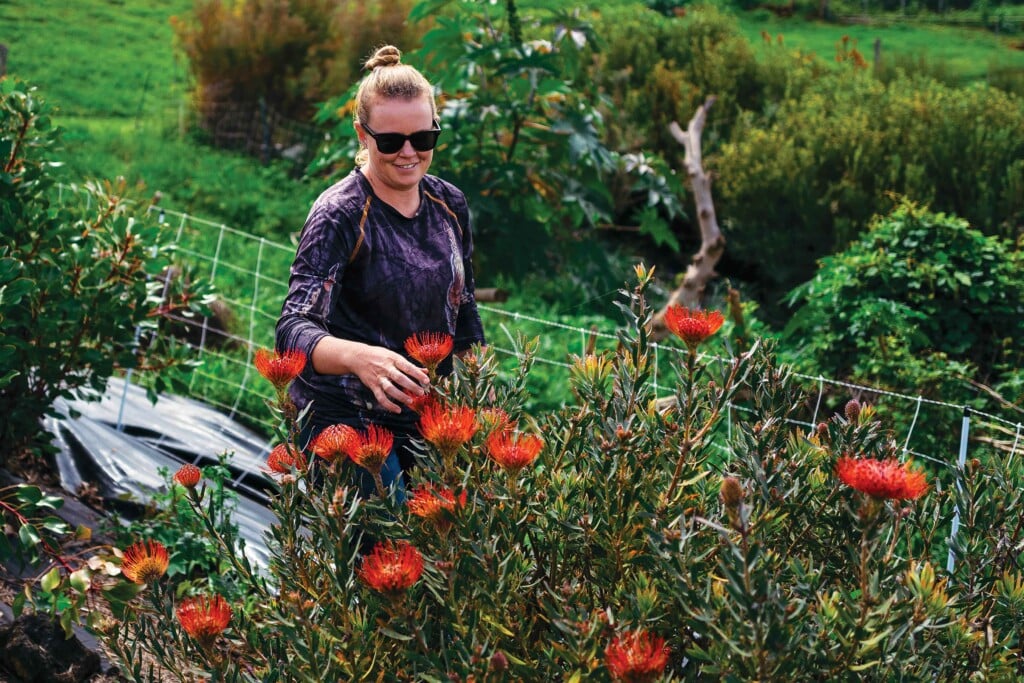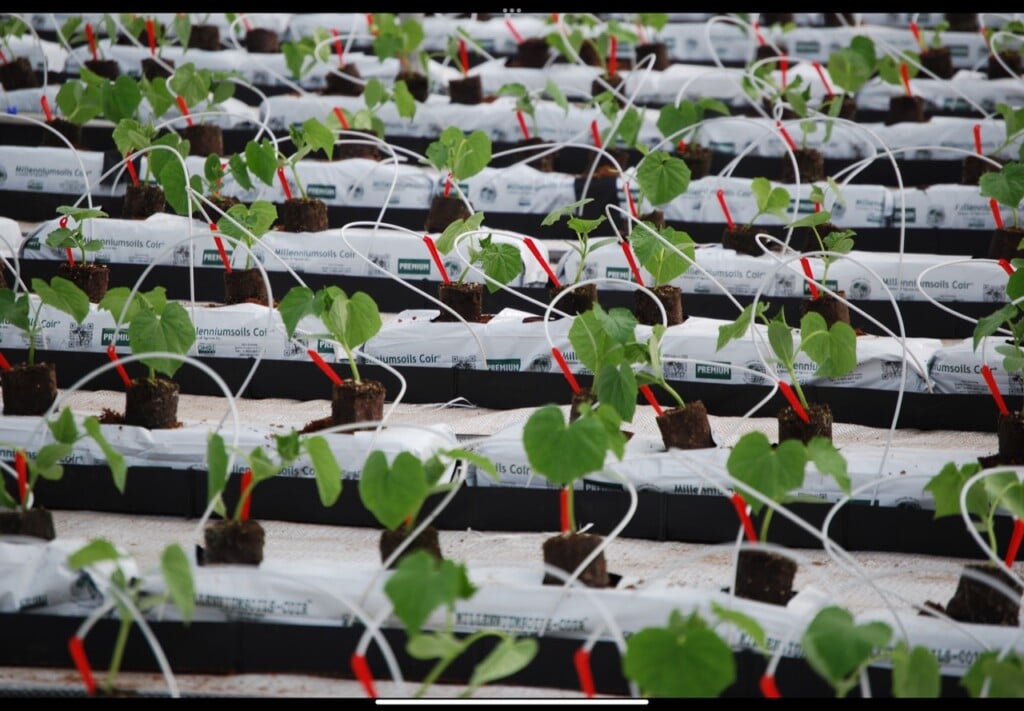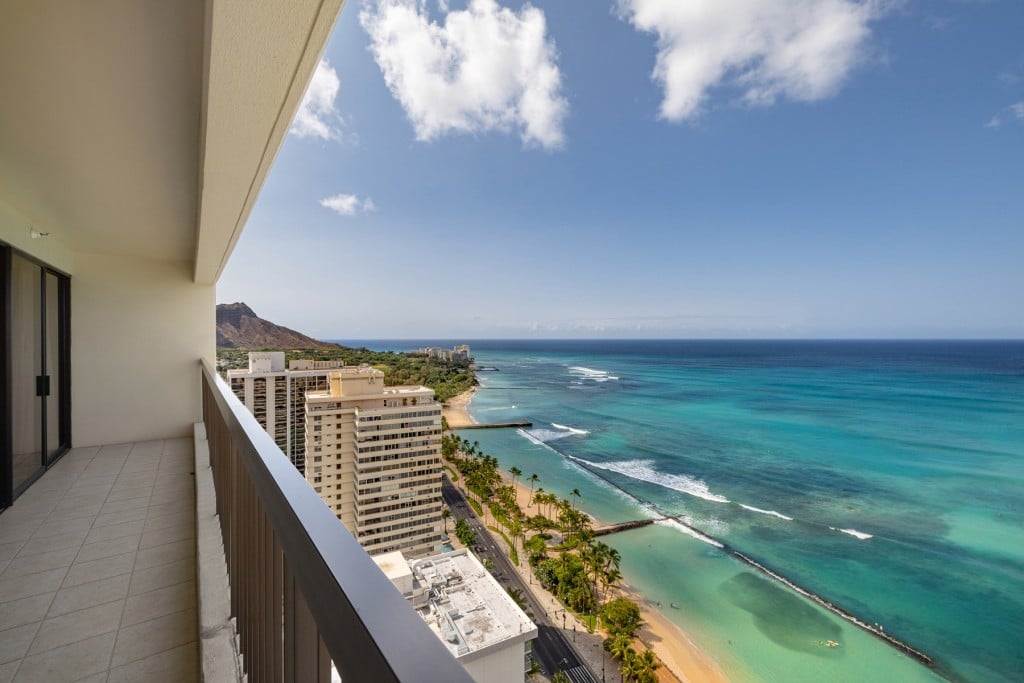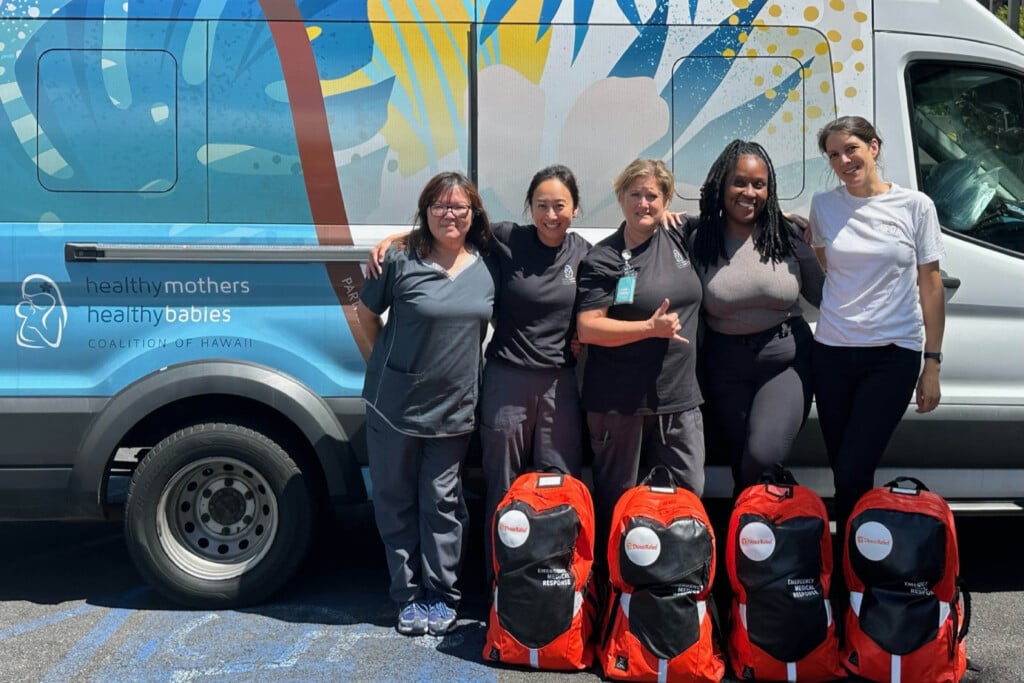People and Places that Grow Hawai‘i’s Food
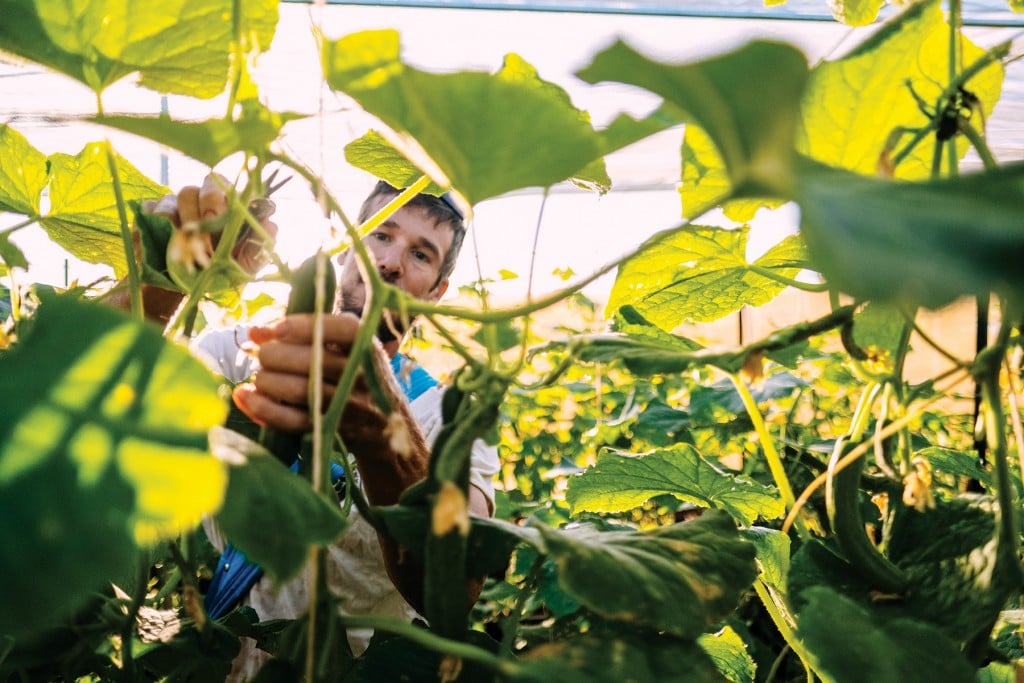
It seems everyone wants more locally grown food.
Here are those making it happen: their successes, challenges and ideas about how to make Hawai‘i more self-sufficient in food.
Alternately fought over and forgotten, land in Lualualei Valley has long served as a barometer for Hawai‘i’s appetite for local agriculture.
The valley, once home to the Wai‘anae Sugar Co., was also where the Araki family and then the Higas produced onions, watermelon, cantaloupe, lettuce, daikon and mustard cabbages from the 1960s through the ’80s. But in 1987, Japanese developer Sanjiro Nakade bought 236 acres in the valley to build a golf course.
“No can eat golf balls,” protested the Higas, facing eviction, and the Wai‘anae community rallied behind them. Nakade put the project on hold, only to bring it back four years later, this time offering an undisclosed payment to the Higas and a “community benefit package” to Wai‘anae. Nakade successfully rezoned the land from agricultural to preservation – the idea was that a golf course could somehow preserve land against more concrete development.
But the golf course was never built after the bursting of Japan’s economic bubble and the land sat untouched for nine years until developers acquired it and tried to rezone, once again, this time to light industrial. During a 2011 planning commission hearing, the audience was almost evenly divided among supporters and opponents of the project.
Gary Maunakea-Forth, who started the nearby 5-acre MA‘O Organic Farms in 2001, said, “If you pass this, it’s missing an opportunity to plan for agriculture for not only this area, but for the whole state.” Patty Teruya, chair of the Nānākuli-Mā‘ili Neighborhood Board, said Nānākuli had been rural for too long and “keeping the country country … did not bring jobs or economic development.”
The project died, one vote shy of approval by the state Land Use Commission, and for almost a decade, the land lay forgotten. Again.
Then at the end of 2019, Ma‘o bought the land with support from a host of nonprofit and for-profit partners.
Maunakea-Forth says that when he and his wife Kukui first started MA‘O (an acronym for Māla ‘Ai ‘Ōpio or “youth food garden”), they didn’t expect to be growing farmers. The goal was community development and to provide college scholarships to kids in exchange for internships on the farm.
“The idea was that working on the farm for some period of their life would be a really fruitful experience for them,” Maunakea-Forth says. “They could have worked at 7-Eleven, but what would they learn there that they wouldn’t learn on the farm?” Farming as a career wasn’t the goal, “partly because we only had a small bit of land, and there were all kinds of impediments for someone young to be a farmer. So we didn’t force that side of things.”
But that was before MA‘O’s newly acquired land and the advent of programs like GoFarm’s statewide farmer training program. And in the two decades since, Maunakea-Forth has seen the rise of the “star farmer” alongside the celebrity chef.
Unprecedented Diversity
Growing food for Hawai‘i is hot right now. In the past decade, farms of unprecedented diversity have spread across the Islands. Large businesses grow next to expanding family farms.
There’s Larry Ellison’s Lāna‘i Farm, a $15 million solar-powered, automated hydroponic greenhouse system, which calculates nutrition rather than yield per acre. And there’s the nonprofit Kāko‘o ‘Ōiwi, steward to about 400 acres in He‘eia; its goal is to restore half of those acres to productive lo‘i, and another chunk to other culturally significant native Hawaiian crops.
Smaller farms have expanded, including Ho Farms, which recently leased 63 acres in the Whitmore Project in Wahiawā, owned and managed by the state Agribusiness Development Corp, and is now up to 100 acres.
Established businesses are venturing into growing food: Kualoa Ranch now cultivates oysters in its fishponds and Mari’s Gardens in Mililani, once primarily an ornamental nursery, now also raises fish and vegetables through aquaponic systems.
Even ‘ulu’s time has come after decades of efforts: the Hawai‘i ‘Ulu Producers Co-op moved more than 18,000 pounds of ‘ulu in 2016, when it started; in 2019 the co-op processed 92,000 pounds of ‘ulu and 55,000 pounds of other crops such as sweet potatoes, grown in concert with ‘ulu trees.
And before the pandemic, public schools were serving more locally grown food to students, including 100% of all fresh beef in schools statewide, or about 28,000 pounds a month.
Using Former Sugar Fields
More than 250,000 acres became available with the plantation closures that began in the 1990s and ended in 2016 when Hawai‘i’s last major sugar company closed. A lot of the land went to seed corn and cattle grazing, both still primarily export crops. Pockets, like the Ka‘ū region, pivoted to coffee, while other tracts, such as on Maui, were subdivided and sold as gentleman estates.
Sensing a business opportunity in growing food locally (it’s widely assumed that around 85% of Hawai‘i’s food is imported, though it’s difficult to verify), a number of large companies plunged into the field. In the past few years, they’ve included:
- Mahi Pono, a joint business between a California investment firm and a Canadian pension fund manager, which pledged to grow food for local consumption, including potatoes, citrus and other crops – on 41,000 acres of former cane land in Central Maui;
- Kalona, which plans an agroforestry model with a focus on cacao and hardwoods interspersed with fruit trees and produce for the local market, on 222 acres of Kamehameha Schools land on O‘ahu’s North Shore; and
- Parker Ranch, one of the largest cow-calf operations in the country, which has pledged to keep some of its cattle for local consumption. Others will continue to be shipped to the Mainland to be fattened on other pastures and feedlots.
- Other larger farms such as greenhouses planned by Costco and a million-egg farm proposed by Indiana’s Rose Acre Farms and California’s Hidden Villa Ranch, two of the country’s largest egg producers and distributors.
The launch of these large farms seems to match what Larry Jefts said in a 2014 Hawaii Business Magazine article entitled, “Can Hawaii Feed Itself?” Jefts owns Sugarland Growers, one of the largest farms in Hawai‘i with 6,000 acres on O‘ahu and Moloka‘i. The article said: “If Hawai‘i is really going to grow its agricultural base, Jefts says, it’s going to be because of people like himself – people with the capital to invest in technology and large-scale operations. ‘We’re not going to build that kind of agriculture with 800 small farmers,’ he says. ‘It’s going to be commercial operations with state-of-the-art agriculture. This is not a popular position, but we have to be efficient at what we’re going to do or we’re not going to be competitive.’ ”
Dairies Struggle
We are gaining farms, but we are also losing farms. Among them: Nalo Farms in Waimānalo, which Dean Okimoto closed and sold to hemp seed growers when storms wiped him out four times in 2018, and Hāmākua Springs Country Farms, which was the largest banana operation on Hawai‘i Island when it closed in 2016 (owner Richard Ha went on to help launch a medical marijuana dispensary). And Glenn and Amy Shinsato, ready to retire and finding no takers for their Kāne‘ohe pig farm, closed it and sold the property to a construction company in 2016 (though 2 Lady Farmers in Wai‘anae helps fill the hole).
Dairies have had an especially difficult time. Idaho farmers bought Big Island Dairy in 2012 and more than doubled its herd, but the operation outgrew its wastewater system. The dairy was fined multiple times by the Hawai‘i Department of Health for contaminating state waters with manure. It closed in 2019 after a lawsuit by community groups.
There’s also the dairy that never was: Hawai‘i Dairy Farms was slated for Kaua‘i and was to be modeled after New Zealand’s method of grass-fed dairy farming. It faced lawsuits by a community group and the owner of Grand Hyatt Kaua‘i and Po‘ipū Bay Golf Course before it even opened. After a five-year effort, it announced in 2019 that it would cease trying.
“The realities of farming are, if we want to be food independent and food secure, we have to make trade-offs,” says Amy Hennessey, spokeswoman for Ulupono Initiative, which committed $17.5 million to the dairy. “There was a time when it was very desirable to have a farm or a ranch as your neighbor because it was a lot of open green space. If done right and managed well, and taking into account best practices that allowed you to be environmentally sustainable, then farming has a real place in our community and we should not attack farmers.”
Putting aside the farm-to-table hype, how much do Hawai‘i’s people really care about growing our food locally? Are they willing to accept trade-offs? When the Honolulu Office of Climate Change, Sustainability and Resiliency conducted a poll, people’s concern about an overreliance on imports was far outweighed by their concern about the cost of living, aging infrastructure, climate change impacts and our lack of affordable housing.
When Sarah Rehkamp, an agricultural economist recently hired by UH’s College of Tropical Agriculture, first came across the goal of doubling local food production, her first thoughts were “why?” and “how?” She says, “What would the food system impacts be? How can we support our local producers and, at the same time, meet consumer demand?’ Based on my training in economic theory, it makes sense to specialize in areas where you have a comparative advantage and trade for efficiency in resources.” Part of her work is to better understand issues relevant to Hawai‘i “from an economist perspective and quantitatively thinking about the trade-offs.”
“The realities of farming are, if we want to be food independent and food secure, we have to make trade-offs.” —Amy Hennessey, spokeswoman for Ulupono Initiative
They sound alike but there’s a difference between food self-sufficiency and food security. A 2019 Global Food Security Index by The Economist Group ranks countries based on three core factors: affordability, availability, and quality and safety. But when you factor in resilience, which measures how well a food supply can weather disasters and climate change, the first-place country, Singapore, drops 11 places in the rankings because of its import dependency and susceptibility to rising seas – which should sound familiar to
Hawai‘i’s people.
Albie Miles, a professor of sustainable community food systems at UH West O‘ahu, argues that we are not currently feeding ourselves by either measure: security or resilience. The USDA estimates 8% of Hawai‘i’s population is food insecure, though the Hawai‘i Department of Health puts the percentage much higher: 16.7% for the general population and 35.7% for Native Hawaiians, which equates to about 237,000 people who don’t have access to healthy food. In cases of disruption, the state estimates it has only enough food to feed the population for five to seven days.
“If we face a similar hurricane to the one that hit Puerto Rico (in 2017), the outcomes would likely be similar,” Miles says. “I think we have been lulled into a certain kind of complacency.” Research from the climate science community shows that as climate change advances, storms will become more frequent and more severe. “You see how all these things can add up to the inability of Hawai‘i to feed itself adequately.”
Data is Missing
In 2016, when Gov. David Ige announced the goal to double the state’s food production by 2020, the last statewide agricultural land use baseline study was in 1980. In other words, nobody knew what we were doubling. But Ige says “Anecdotally, in talking to farmers, we see that production is significantly higher in a lot of different things.”
The Hawai‘i Department of Agriculture commissioned another baseline study in 2015, which helped provide a snapshot of agricultural land use and water resources, but the data was still spotty. The baseline did not address crop production numbers, consumption patterns or food imports “because Hawai‘i no longer makes a sustained effort to collect this important data,” wrote the authors. “This lack of basic agricultural data makes it easy to pronounce new local food goals, but there is no real way to measure progress toward successful agriculture or enhanced local food self-reliance.”
Some existing data seems to support anecdotal evidence that new farms and new farmers are on the rise. According to the 2017 agricultural census, in the 5 previous years, there was a 5% increase in Hawai‘i farms, mostly large and small ones (more than 2,000 acres and fewer than 9 acres, respectively). Hawai‘i ranked fourth in the country with 32% of producers having fewer than 10 years of farming experience; the national average is 27%.
Rob Barreca, who started Counter Culture in Waialua, is one of the new farmers. As I drive to the North Shore to visit the farm, the pineapple fields and ruins of Waialua Sugar Mill are easy to spot. Harder to find is the mango tree that serves as my marker for the road to Counter Culture. I pass Hale‘iwa Elementary School a few times before finally seeing it.
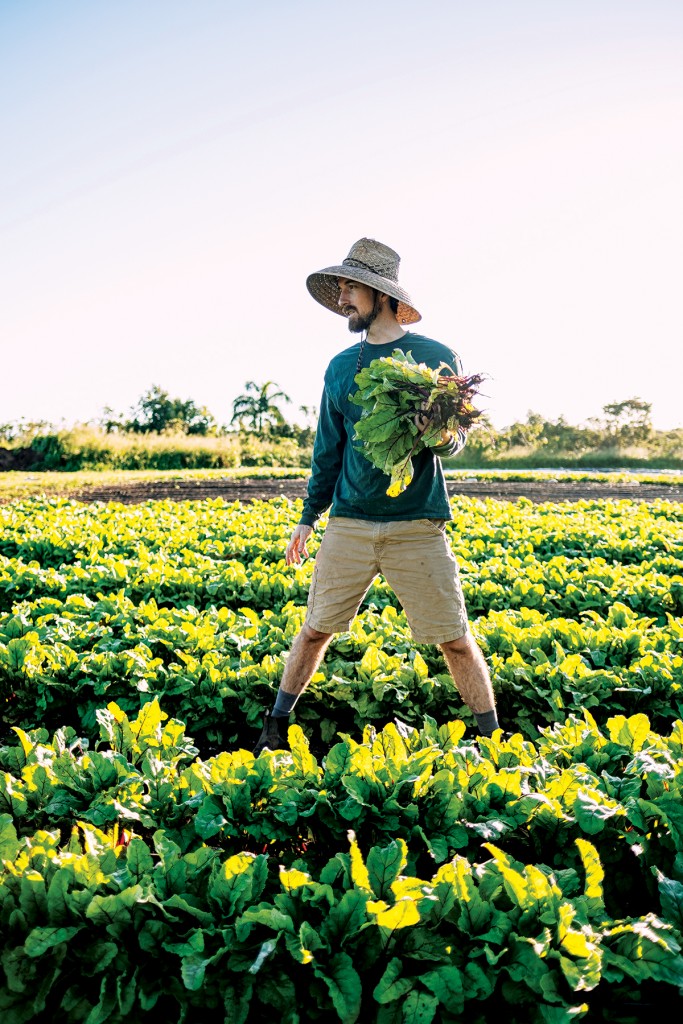
Counter Culture Farm founder Rob Barreca, thins a densely planted beet field. | Photos: Aaron Yoshino
As I head down an unmarked gravel path between houses, it feels like passing through the hidden Hogwarts train platform. I’ve entered a world largely invisible to city dwellers, but one that feeds them: There’s Twin Bridge farm, best known for its asparagus; herbs harvested by Waialua Growers; land leased by Pūpūkea Greens; and Hawaiian Shochu Co., fermenting locally grown sweet potatoes into a spirit. All of this wedged between the two main roads that run through Hale‘iwa.
Barreca leads me through Counter Culture, which he started in 2015 with a five-year rent-free lease and $20,000 from Kamehameha Schools’ Mahi‘ai Matchup agriculture business plan competition. Last year he leased an additional 30 acres from the seed-grower Corteva, the largest stand-alone agricultural company in the world.
The former web designer left that job “to broadly do something in food and find some meaning in my life,” he says. He enrolled in the GoFarm program, where an instructor, Jay Bost, inspired him about growing.
Barreca shows me a fresh harvest of ginger, and we drive past a small flower patch in which his partner, Laarni Gedo, experiments with amaranth varieties Love Lies Bleeding and Hot Biscuit.
We pass a test plot of corn bred for disease resistance, a banana grove that Barreca says contains a hundred different varieties of bananas, plus a plot to supply Banán, which loaned Counter Culture $10,000 to grow bananas for its banana soft serve dessert. “It’s not just like this is a production of sustenance material,” he says. “This is a really dynamic part of our existence in life.”
For Barreca, growing is the easy part; getting what he’s growing to people was the struggle. To address that, he also founded Farm Link Hawai‘i, an online platform that connects farmers with buyers, around the same time he started Counter Culture.
“Dealing with restaurants and grocery stores every week is an oppressive amount of work. It’s the communication – when is (the produce) going to be available, what’s it look like, when do they need to order by, what’s the case size, can you get there by the time their receiving closes? Every restaurant is different and has different specifications.”
The giant mess seemed solvable to Barreca. In 2019, Farm Link connected 109 suppliers, ranging from small farms to backyard growers, with 118 commercial buyers, from Fête to Foodland, and 180 households. It moved $400,000 of produce last year, and he estimates it’s on track for $750,000 this year.
Both Counter Culture and Farm Link, however, operate at a loss. Barreca remains optimistic: “I think it’s viable, not easy, but doable. Every quarter, we’re doing better and better, and all the graphs are moving up.
“It doesn’t feel like we’re alone in this. We’re seeing a ton of other people that are slowly incrementing their production, finding better opportunities, getting more efficient and developing more relationships with buyers that are more predictable and financially beneficial for the farmer. Each round makes it easier for the next round of farmers to enter.”
Not All Our Food
“We can feed ourselves for sure, but the goal doesn’t have to be 100%,” says Gary Maunakea-Forth, echoing what most farmers I talked to say. No one wants to give up their cheesecake, Champagne and caviar, as UH West O‘ahu’s Miles says. Not to mention wheat, which doesn’t grow well in the tropics.
“But we can get to a really happy place where agriculture is really supporting some of the economy, where we’re not missing the boat on some of the things,” Maunakea-Forth says. “Tourists eat a mango and nine months of the year, it comes from Mexico. Let’s turn our 10 million tourists to the way it should be. Increase the amount of mangoes we grow. We still have french fries, why not ‘ulu fries?”
MA‘O Organic Farms is the largest organic farm in Hawai‘i, producing about 80 tons of produce annually, and with its new land acquisition, Maunakea-Forth estimates ramping up to 1,400 tons (for scale, this is almost half of Hawai‘i’s entire production of green coffee beans in 2014). It is also a nonprofit: Maunakea-Forth sees MA‘O as community-level farming and trying to effect systemic change by integrating farming, education, Hawaiian culture, food security and health.
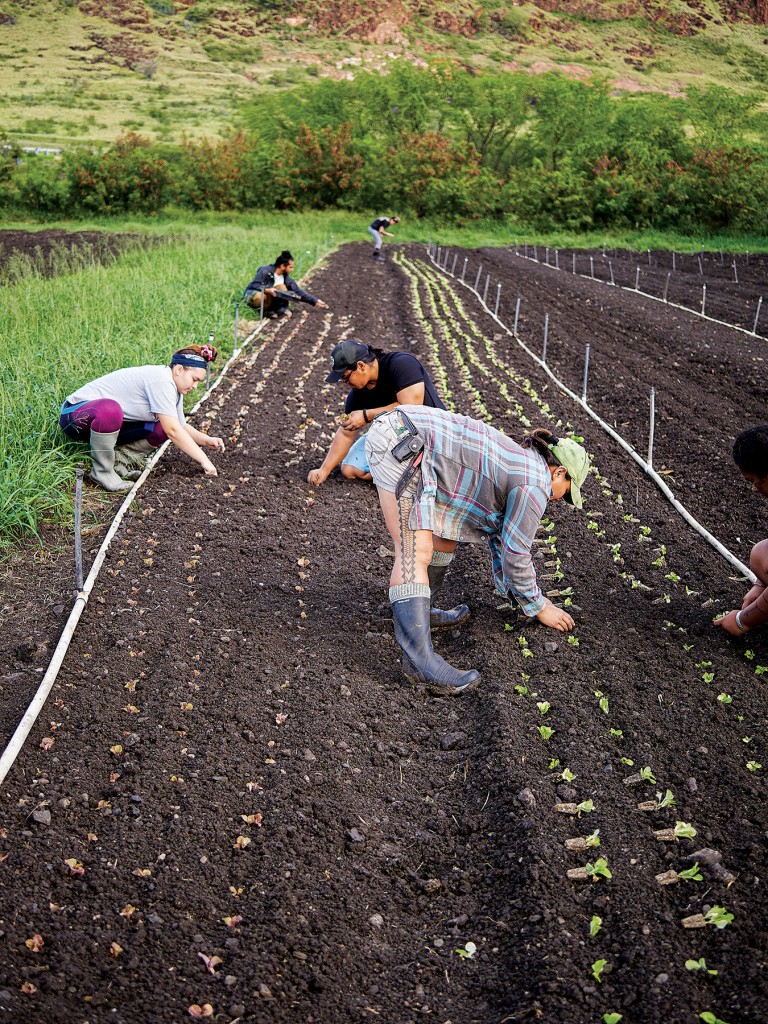
The MAʻO Farm’s manager, Kaui Sana, a former intern, transplants lettuce along with interns Olivia and Andrew and apprentice Josh. | Photo: David Croxford
“Our version of health is not just giving people free vegetables. It’s getting kids to college so that they’re more educated. When they’re more educated, they cook better, they eat better food, they’re more aware of diet and exercise. At the same time, we’re pumping up local farmers markets with affordable organic veggies and getting our food into our neighborhood, like Tamura’s and Sack N Save in Nānākuli.” So far, MA‘O has produced more than 130 college graduates with associate or bachelor’s degrees.
Its measure is not one farm’s or one owner’s profits, but a community’s health. While MA‘O anticipates that the new land acquisition will allow it to grow its percentage of earned revenue from 35% to more than 90% of its operating budget, it will still require grants and donations. It is not unlike the news media industry, its business model drastically changed in the past decade, and has seen a rise in nonprofits and individuals stepping in to support what they believe to be a public good.
What’s different now, though, from when MA‘O first started, is the nature of its support. The new land purchase is in part financed by donations from foundations including the Sullivan Family Foundation (started by the founders of Foodland) as well as a low-interest loan by Central Pacific Bank guaranteed by Kamehameha Schools.
“Our version of health is not just giving people free vegetables. It’s getting kids to college so that they’re more educated. When they’re more educated, they cook better, they eat better food, they’re more aware of diet and exercise. —Gary Maunakea-Forth, Founder of MA‘O Organic Farms
“There are some local businesses that understand that large investments are required to solve societal problems – more and more they are partnering with community-based organizations like MA‘O, and that’s a breath of fresh air,” Maunakea-Forth says. Whereas before, giving back to the community might have entailed end-of-year donations or raffles, he sees that more businesses are folding community development into their core missions.
What’s also changed is how he’s practically mobbed when he goes to the farmers market: “People are just super motivated to get local food.” He says the overall environment has improved so much that now he’s “unabashed” about trying to get some of his interns to become farmers.
Maunakea-Forth started MA‘O for social justice, but he farms “because I love food, because I love the mountains, the soil, water, plants; I’m excited and inspired when a seed germinates, when I harvest a carrot I farm, when someone shares how they cooked our kale and our beets. I farm because I love eating long meals of great local food with good ‘ohana (in the broadest sense of the term), because I want justice for the earth and for people – because I want to live aloha ‘āina on a daily basis.”
